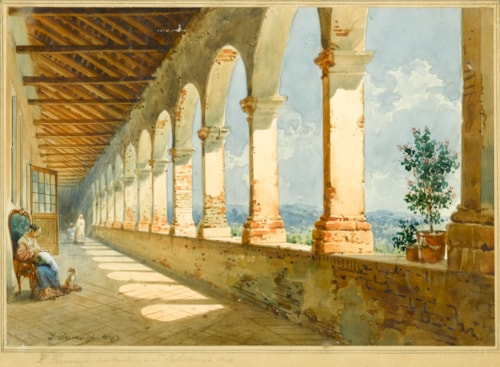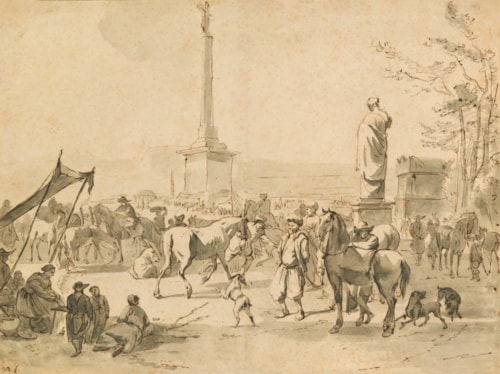ean-Baptiste Pillement
(Lyon 1728 - Lyon 1808)
Peasants Resting and Dancing to a Piper beside a Farm
signed and inscribed 'Jean Pillement l’an 4. D. La. R.' [1795-6] (lower left)
black chalk, stumping, grey wash, brown and black ink framing lines
35.5 x 48.3 cm (14 x 19 in)
This drawing by Jean-Baptiste Pillement shows a group of peasants relaxing in the sunshine by the side of a farmhouse. On the left-hand side two men sit on a grassy bank, each talking earnestly to a woman. In the centre of the composition, another couple are dancing on the tips of their toes. The man is trying to take his partner’s arm but she is distracted while in conversation with the group of figures who sit on the ground nearby. Musical accompaniment is provided by the young piper perched on a large barrel and beyond him another weary figure looks on. The landscape itself is uneven and grassy, dotted with rocks, shrubs and small piles of logs that are presumably used by the farm. The background is faint, although the occasional tree and contour of the mountains are still discernible. The whole scene is cast in light and bright sunshine.
The composition of the present work was used repeatedly throughout the latter part of Pillement’s career, in particular the right-hand featuring the dancers, musician and cottage. Country Feast, (Private Collection) is a pastel en griselle, which features a very similar group of revellers, albeit with two fewer figures and slightly differing poses. Another variation, Scène de Vie Paysanne, of 1804 is in the Musée des Art Decoratifs in Lyon¹ and Maria Gordon Smith also records several depictions of the young flautist among Pillement’s travel sketches that belong to the Musée des Beaux-Arts in Lyon.²
The present work can be dated to the period 1789-1800, when Pillement was living in the south of France. He had returned home, after working in the Iberian Peninsula, in the same year that the French Revolution broke out. Due to his ties to the monarchy, it seems probable that Pillement felt he was in some danger, and so rather than settle in Paris, or his native Lyon, he moved near the small town of Pézenas in the Hérault region.³ In this context it is notable that Pillement has dated the present work using the new calendar of the Republic.
Pillement had a prolific and varied career, and his work found favour with prestigious patrons throughout Europe. Having received his initial training in his hometown of Lyon, from Daniel Sarrabat (1666-1748), at the age of just fifteen he was accepted by the prestigious Gobelins manufactory of tapestries. However, his ambitious and restless nature soon led him to move to Spain, and then on to Portugal where he worked as a painter and a designer. Whilst still in his twenties, he was offered the position of Painter of the King, to José I of Portugal (1714-1777), but he declined the honour. He believed that the position “was not sufficient reason to dissuade him from the desire of learning through travel” and so instead moved to London.⁴
Pillement had great success in England, finding favour with patrons, engravers and publishers. His drawings were frequently engraved in London for Rococo pattern books, and in 1767 an influential collection of prints of his decorative, genre and landscape subjects was published as One Hundred and Thirty Figures and Ornaments and Some Flowers in the Chinese Style. This and other pattern books were widely used by textile designers. He remained in London intermittently until 1762, but also spent time working in France, Holland, Rome, Florence, Milan, Switzerland, Germany and Vienna. In the latter he was employed at the Imperial Court of Maria Theresa and Francis I, and he also worked for the Prince of Liechtenstein, before becoming First Painter to the King of Poland. Eventually he returned to Portugal in 1780 and again in 1783, before returning to France five years later where he spent the rest of his life, and it was during this late period when he drew the present work. His paintings were as varied as his travels, and as Gordon-Smith writes ‘he infused each work to which he set his hand with a boundless imagination, an unbridled spirit, and a tireless pursuit of beauty’.⁵
¹ Inv. 1888.2. Illustrated in Gordon-Smith, M., Pillement (Cracow, 2006), p.303, fig. 311.
² Ibid. p. 304
³ Pillement had previously held the titles of Premier peintre du Roy de Pologne (1767) and Peintre de la Reine Marie-Antoinette (1778). For more on the impact of the revolution upon artists’ lives, see Ibid pp. 245-246.
⁴ Ibid. p.19.
⁵ Ibid, p. 18.
This drawing by Jean-Baptiste Pillement shows a group of peasants relaxing in the sunshine by the side of a farmhouse. On the left-hand side two men sit on a grassy bank, each talking earnestly to a woman. In the centre of the composition, another couple are dancing on the tips of their toes. The man is trying to take his partner’s arm but she is distracted while in conversation with the group of figures who sit on the ground nearby. Musical accompaniment is provided by the young piper perched on a large barrel and beyond him another weary figure looks on. The landscape itself is uneven and grassy, dotted with rocks, shrubs and small piles of logs that are presumably used by the farm. The background is faint, although the occasional tree and contour of the mountains are still discernible. The whole scene is cast in light and bright sunshine.
The composition of the present work was used repeatedly throughout the latter part of Pillement’s career, in particular the right-hand featuring the dancers, musician and cottage. Country Feast, (Private Collection) is a pastel en griselle, which features a very similar group of revellers, albeit with two fewer figures and slightly differing poses. Another variation, Scène de Vie Paysanne, of 1804 is in the Musée des Art Decoratifs in Lyon¹ and Maria Gordon Smith also records several depictions of the young flautist among Pillement’s travel sketches that belong to the Musée des Beaux-Arts in Lyon.²
The present work can be dated to the period 1789-1800, when Pillement was living in the south of France. He had returned home, after working in the Iberian Peninsula, in the same year that the French Revolution broke out. Due to his ties to the monarchy, it seems probable that Pillement felt he was in some danger, and so rather than settle in Paris, or his native Lyon, he moved near the small town of Pézenas in the Hérault region.³ In this context it is notable that Pillement has dated the present work using the new calendar of the Republic.
Pillement had a prolific and varied career, and his work found favour with prestigious patrons throughout Europe. Having received his initial training in his hometown of Lyon, from Daniel Sarrabat (1666-1748), at the age of just fifteen he was accepted by the prestigious Gobelins manufactory of tapestries. However, his ambitious and restless nature soon led him to move to Spain, and then on to Portugal where he worked as a painter and a designer. Whilst still in his twenties, he was offered the position of Painter of the King, to José I of Portugal (1714-1777), but he declined the honour. He believed that the position “was not sufficient reason to dissuade him from the desire of learning through travel” and so instead moved to London.⁴
Pillement had great success in England, finding favour with patrons, engravers and publishers. His drawings were frequently engraved in London for Rococo pattern books, and in 1767 an influential collection of prints of his decorative, genre and landscape subjects was published as One Hundred and Thirty Figures and Ornaments and Some Flowers in the Chinese Style. This and other pattern books were widely used by textile designers. He remained in London intermittently until 1762, but also spent time working in France, Holland, Rome, Florence, Milan, Switzerland, Germany and Vienna. In the latter he was employed at the Imperial Court of Maria Theresa and Francis I, and he also worked for the Prince of Liechtenstein, before becoming First Painter to the King of Poland. Eventually he returned to Portugal in 1780 and again in 1783, before returning to France five years later where he spent the rest of his life, and it was during this late period when he drew the present work. His paintings were as varied as his travels, and as Gordon-Smith writes ‘he infused each work to which he set his hand with a boundless imagination, an unbridled spirit, and a tireless pursuit of beauty’.⁵
¹ Inv. 1888.2. Illustrated in Gordon-Smith, M., Pillement (Cracow, 2006), p.303, fig. 311.
² Ibid. p. 304
³ Pillement had previously held the titles of Premier peintre du Roy de Pologne (1767) and Peintre de la Reine Marie-Antoinette (1778). For more on the impact of the revolution upon artists’ lives, see Ibid pp. 245-246.
⁴ Ibid. p.19.
⁵ Ibid, p. 18.





 contact
contact contact
contact +44 20 7313 8040
+44 20 7313 8040









